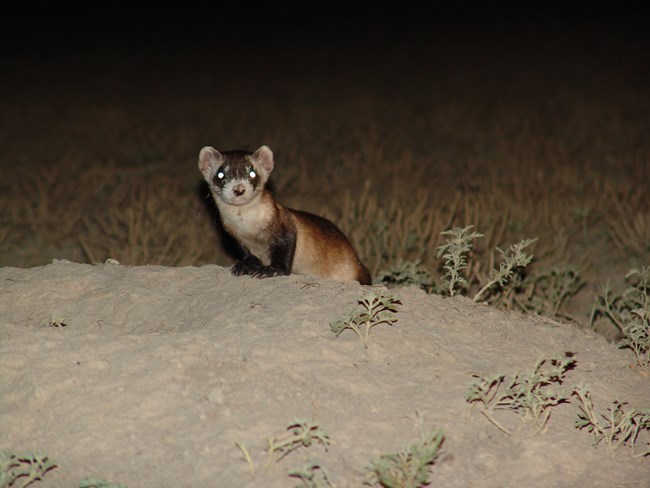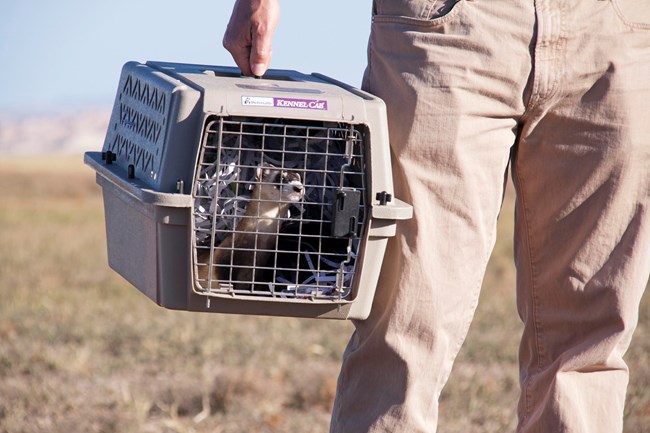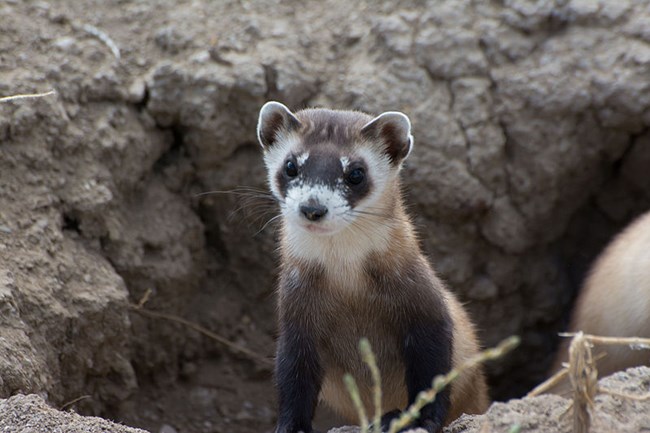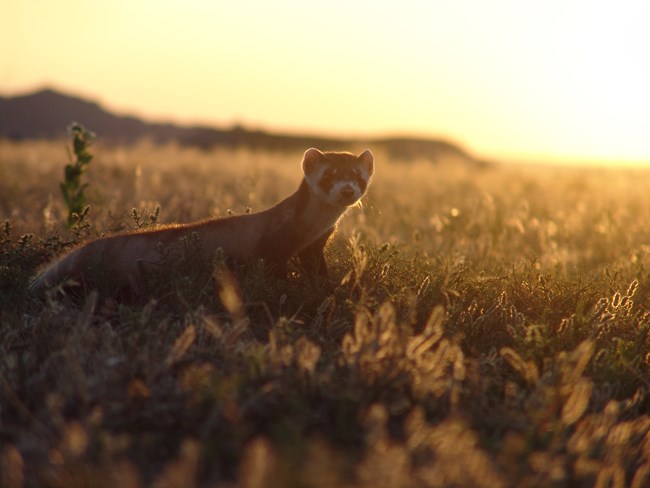Part of a series of articles titled Wildlife in the Badlands.
Article
Black-footed Ferret: Rebounding in the Badlands

NPS Photo

NPS Photo
A Day in the Life
A day in the life of a ferret isn’t really a day at all – ferrets are nocturnal, meaning that they are active at night, as opposed to diurnal critters which are active during the day. Ferrets sleep up to 21 hours per day and wake up at night to hunt, eat, and tend to their young. Black-Footed Ferrets are solitary animals with the exceptions of breeding season and caring for their young.
Mating season for ferrets runs from March to April. Black-Footed Ferrets have a gestation period of 41-43 days and commonly produce litters of around 3-5 kits, but extreme litter sizes can range from 1-7 kits. Kits are born blind and helpless – they stay underground until they’re about two months old, at which point the jills will move their litters to various burrows within their home ranges and start taking kits on hunting forays. At around 90 days of age, kits are about 90% of their full size, adept at killing prairie dogs, and ready to start out life on their own.
In addition to being nocturnal, Black-Footed Ferrets are fossorial, meaning that they live underground. Ferrets live in abandoned prairie dog burrows to maximize their proximity to food sources, raise their young, and escape harsh weather and predators. Their choice of home is a double-edged sword: prairie dogs are plentiful and food is never far, but the human activities and diseases which can decimate prairie dogs can also decimate Black-Footed Ferrets.
Ferrets rely heavily on prairie dogs not only for their homes, but also for food. Prairie dogs make up a whopping 90% of a Black-Footed Ferret’s diet (with the remaining 10% made up of prey like squirrels, mice, and other rodents). One ferret eats a prairie dog about every three days. One Black-Footed Ferret can easily eat around 100 prairie dogs a year, and the average ferret family requires at least 250.

NPS Photo
Back From The Dead!
Black-Footed Ferrets were declared extinct in 1980. But we know this can’t be true – ferrets are thriving in Badlands National Park today! So… what happened? Why were ferrets declared extinct? If that’s true, how is it possible that they exist today?
To answer these questions, let’s go back to the beginning: ferrets evolved in Europe between 3 and 4 million years ago, and scientists estimate that Black-Footed Ferrets have been present in North America for at least 100,000 years. Their historic range stretched through the Great Plains, reaching from Canada to Mexico. In the early 1900s, it is likely that the US contained more than 5 million ferrets – a population of great size that didn’t last long.
As European expansion changed the landscape of the American West from wilderness to agricultural lands, different members of the plains ecosystem faced new challenges. In particular, prairie dogs were hit hard, often exterminated on farms and ranches by rodent poisons. Because about 90% of a Black-Footed Ferret’s diet is prairie dog, the ferrets also suffered in great numbers.
Black-Footed Ferrets were listed as endangered in 1967, and by 1974, the last known wild ferret population (located in Mellett County, SD, just 81 miles away from Badlands National Park) vanished. Just four years later in 1980, the last captive Black-Footed Ferret died, and the species was thought to be extinct…
…until Shep came along. Shep was a ranch dog on a farm in Meeteetse, Wyoming who killed a Black-Footed Ferret and brought it to his owners in 1981. Shep’s owners took the ferret to a local taxidermist, who informed them of the importance of Shep’s discovery. A small relic population of 130 ferrets was discovered on the Wyoming farm and was monitored closely by wildlife biologists. Unfortunately, this population suffered from disease. By 1987, only 18 of the original 130 ferrets remained. At this point, scientists captured the remaining Black-Footed Ferrets, and these ferrets became the foundation for later reintroductions.

NPS Photo
Conservation Efforts
Beginning with Wyoming in 1991, Black-Footed Ferrets have been reintroduced to 29 sites across 8 states, Canada, and Mexico. About 280 Black-Footed Ferrets are currently living in captive breeding facilities and, according to Nature Conservancy, about 200-300 ferrets now live in the wild. About 3,000 Black-Footed Ferrets are necessary to fully recover the species.
Although the hundreds of living ferrets today is an improvement upon near-extinction, the Black-Footed Ferret is still an IUCN (International Union for Conservation of Nature) endangered animal and is one of the most endangered animals in North America. The species is still at risk from disease, loss of habitat, and related declines in prey.
Predators of the Black Footed Ferret include golden eagles, owls, coyotes, badgers, and bobcats. While it’s normal for small animals to have so many predators, reintroduced ferrets are at a heightened risk because animals raised in captivity typically lack some survival skills. Although predators of the Black-Footed Ferrets can be found in abundance, one of the most serious risks to the long-term survival of the species is disease. Ferrets have faced serious challenges when it comes to sylvatic plague, which is the name used for the Black Death when found in animals. Sylvatic plague is a fast-spreading bacterial disease which is carried by fleas, and conservationists have come up with creative ways of preventing the spread of this disease to ferrets. One is a peanut-butter flavored oral vaccine bait. This bait was developed with prairie dogs in mind, helping them to build immunity against the disease. If prairie dogs can avoid the plague, ferrets are at less risk, too. Organizations like the World Wildlife Fund and the US Fish and Wildlife Service are also experimenting with drones to see if they can drop this bait across thousands of acres of prairie dog colonies.

NPS Photo
Black-footed Ferrets In The Badlands
From 1996-1999, a total of 147 Black-Footed Ferrets were released into the Conata Basin area of Badlands National Park. The population did well, and in 2007, the park was able to capture and transfer 33 ferrets to a new home at Wind Cave National Park, where a population of about 60 ferrets also thrives today.
In 2008, sylvatic plague (known as the Black Death when found in humans) was discovered in Conata Basin. Sylvatic plague is carried by fleas and can be extremely dangerous for ferrets when it infects prairie dogs; since prairie dogs are the majority of a ferret’s diet, if prairie dogs get the plague, it is likely that ferrets will too. In order to minimize this risk, research crews were able to vaccinate some ferrets in addition to dusting prairie dog holes with insecticide to prevent the spread of fleas.
Scientists currently estimate that there are about 120 Black-Footed Ferrets living in Badlands National Park, with Nature Conservancy estimating that about 80 of them remain in the Conata Basin area. Wildlife biology crews still monitor and spotlight for ferrets yearly, keeping close tabs on the health of the populations here. The Badlands is home to one of the only self-sustaining Black-Footed Ferret populations in the world, meaning that the population here doesn’t need to be supplemented by ferrets raised in captivity. Our ferrets reproduce and sustain the population on their own.
Last updated: November 10, 2020
